Sage Flow Motion
Wheel Size: 29’’
Travel: Hardtail / 150 mm front
Material: Titanium
Blister’s Measured Weight: 27.3 lb / 12.4 kg
Price:
- Frame only: $4,600
- Framesets and custom builds available (see below)
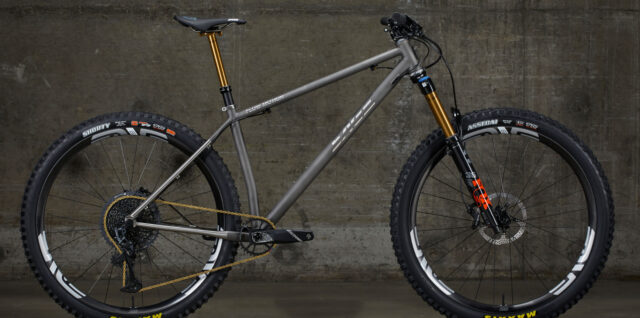
Intro
Sage has been building titanium bikes in Portland, Oregon since 2012, and earlier this year they unveiled the latest iteration of their Flow Motion aggressive hardtail. It’s now a 29er (the prior generation had 27.5’’ wheels), and the geometry has gotten the typical longer / lower / slacker modernization that you’d expect. But Sage also talks a lot about the Flow Motion being “light and snappy,” so in the hardtail category, where does it fall on the spectrum between true XC bikes and the biggest, longest bruisers on the market?
The Frame
Like all of Sage’s bikes, the Flow Motion is made from titanium in Portland, Oregon. It’s a 29er hardtail built around a 150mm-travel fork, and Sage talks about it both being fairly capable on steeper, more technical trails but also describes it as being quick, light, and playful. And as we get into in the “Fit & Geometry” section below, that sounds about right, based on its specs.
The Flow Motion features internal cable routing for the brake and dropper post but, interestingly, runs the derailleur cable externally under the top tube. Those cable guides bolt on, and the default option is for an interrupted housing run with a bare cable under the top tube, but versions for full-length housing are also available. And if you’d prefer, fully internal routing is also an option for made-to-order frames; just ask Sage for what you want. The standard graphics are decals in a variety of color options, or the bead blasted and polished finish (as seen on our test bike) is available for an upcharge, which looks spectacular.
To round out the other details, the Flow Motion uses a T47 threaded bottom bracket shell and standard 148 mm Boost rear end. The headtube is a 44mm one (for a tapered steerer tube with an external lower headset cup) and the Flow Motion uses a 31.6 mm seatpost. There are also two bottle mounts (one on either side of the downtube). Tire clearance is stated up to 2.4” wide, but Sage cautions that nominal tire sizes vary significantly, and a 60 mm knob-to-knob width, with the tire mounted and inflated is the upper limit. Clearance is a bit snug, and the aggressive shaping of the chainstays actually means that you can’t take the wheel on or off with the tire inflated on our pre-production test bike; Sage says that’ll be ironed out the production models.


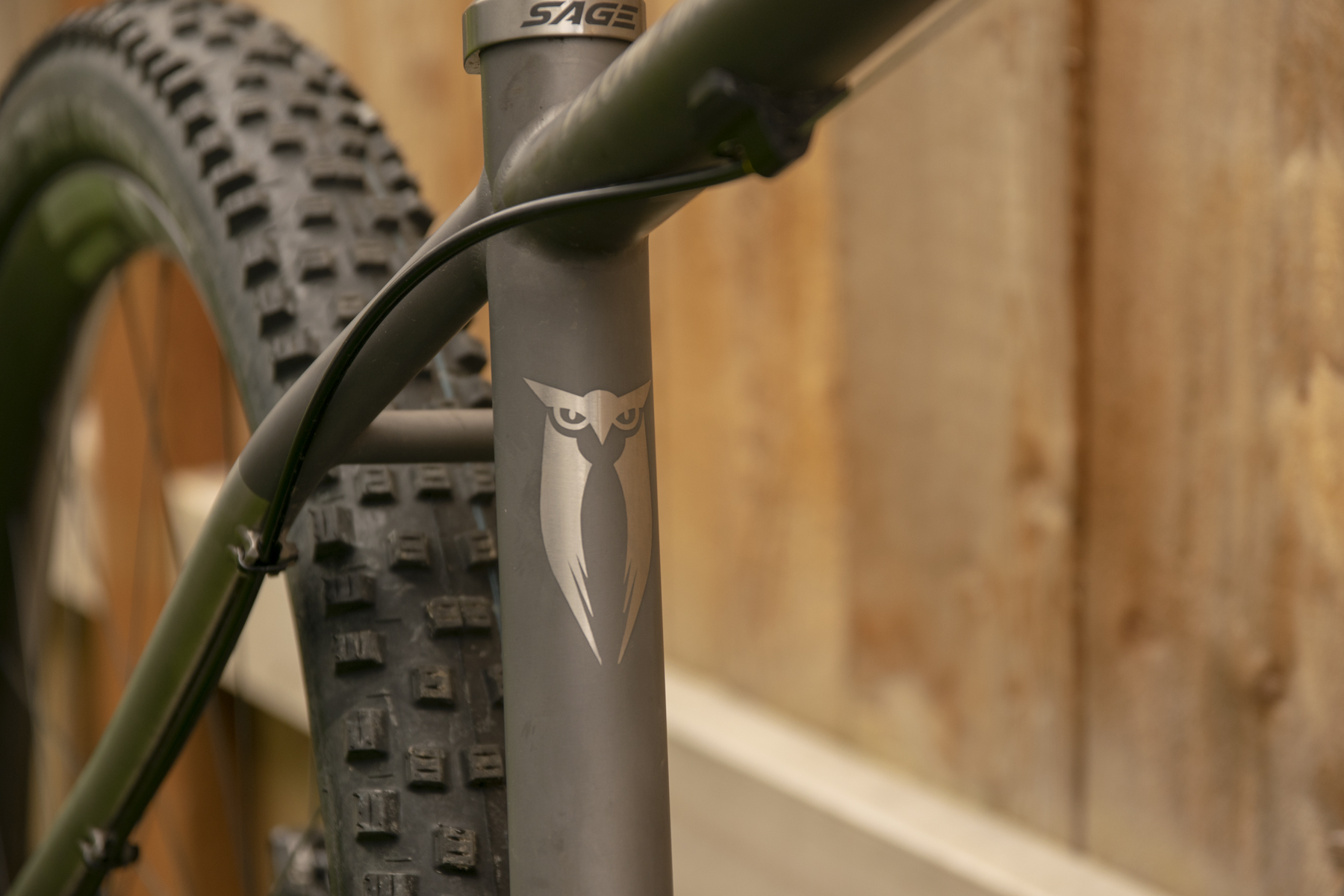

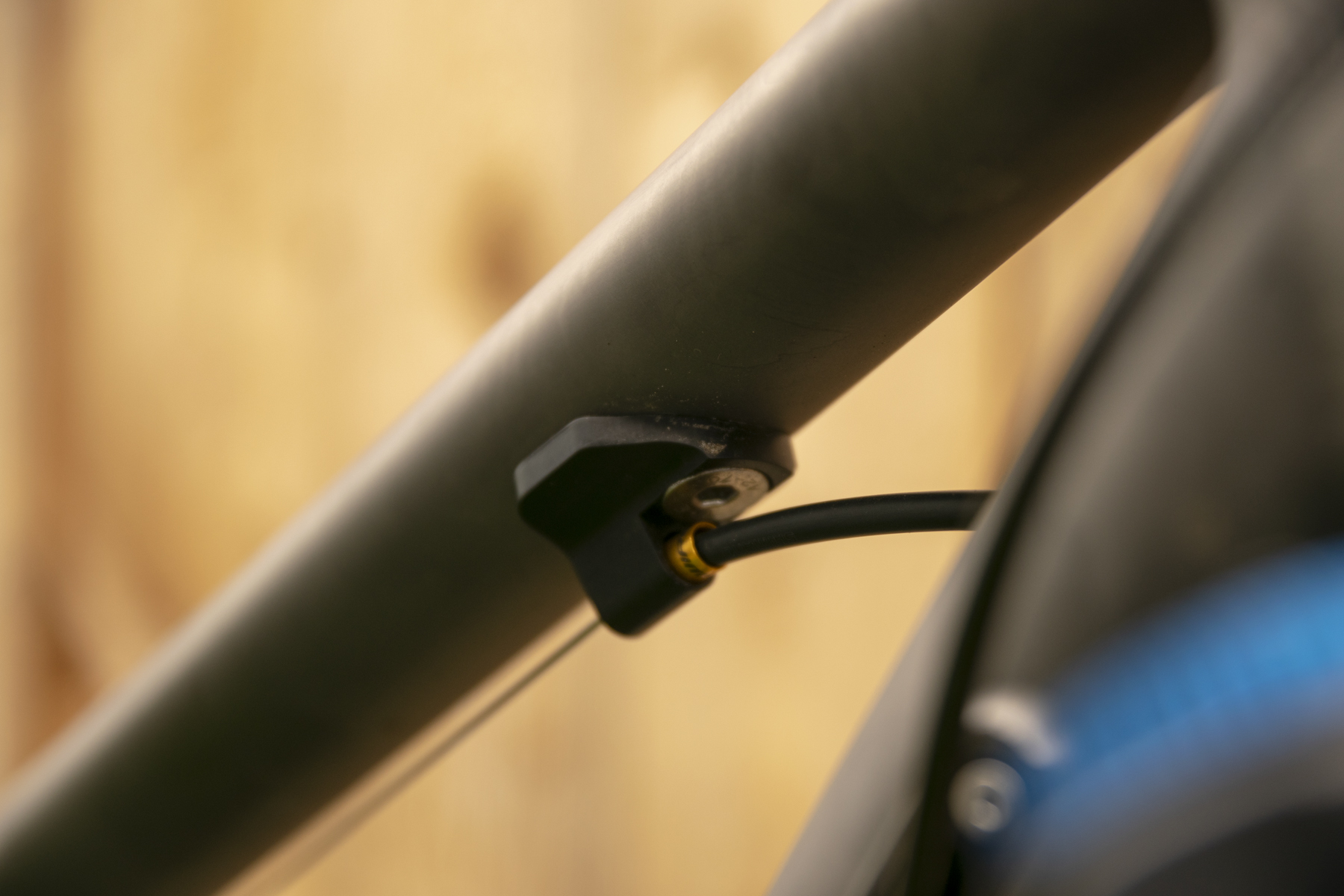


Fit & Geometry
Sage offers the Flow Motion in four sizes, from Small through XL. All get a 64° headtube angle, 77.6° effective / 76° actual seat tube angles, and reach ranges from 425 mm on the Small through 510 mm on the XL. Our size Large test bike’s reach comes in at 491 mm. The bottom bracket drop is 53 mm on the Small and increases by one millimeter per size up to 51 mm on the Large and XL. That probably sounds like a whole lot of drop to folks who are used to looking at full-suspension bike geometry charts, but keep in mind that we’re talking about a hardtail with no rear suspension to sag through. For an aggressive 29er hardtail, that’s actually fairly moderate.
Our review bike is a pre-production model that has 425 mm chainstays, but on the production bikes, those have been lengthened to 430 mm on the Small and Medium frames, and 432 mm on the Large and XL; the geometry is otherwise identical. And if you want to do something different from the stock Flow Motion, Sage also offers custom geometry for an upcharge. Pricing varies depending on the design details, so check with them to discuss options.
The stock geometry on the Flow Motion is a bit more moderate than the absolute most aggressive options out there — bikes like the Marin El Roy and Kona Honzo ESD — but is still longer and slacker than a whole lot of the Trail hardtails out there, especially titanium options which are often somewhat more conservative. It is, however, notably similar to the Knolly Tyaughton, which is available in both a steel and titanium version, and on paper, it looks like it should make for a bike that’s fairly stable and capable in steeper terrain, but not so flat out aggressive that it’s a total handful on mellower trails. But we’ll find out a whole lot more soon, as we put more time on the Flow Motion.
The Builds
Sage doesn’t have any stock builds on offer for the Flow Motion; rather, you can buy a frame only, a frameset, or a custom build through Sage. Their website has a configurator to spec out whatever you’d like. The overview of our review bike’s build is below, and you can check out Sage’s website for the build configurator, which includes pricing information as you work through it.
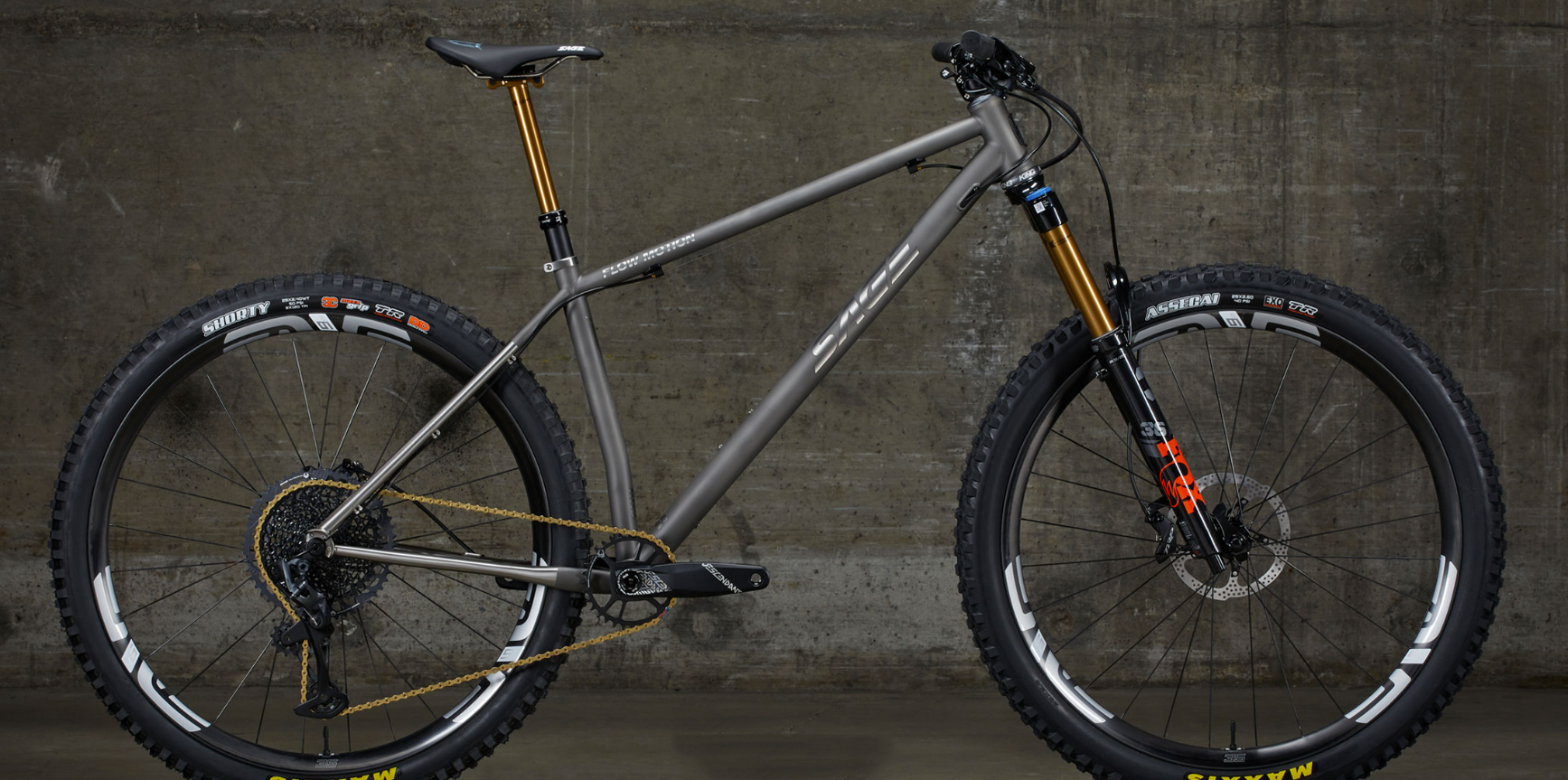
Sage Flow Motion
- Fork: Fox 36 Factory Grip2, 150 mm
- Drivetrain: SRAM X01
- Brakes: TRP Q2.3 SE, 180 mm rotors
- Wheels: Enve M635 rims / Industry Nine Hydra hubs
- Dropper Post: Fox Transfer Factory, 175 mm
That is, unsurprisingly, a very nice build, and one that seems nicely in keeping with the intentions of the Flow Motion — somewhat burly, but still reasonably lightweight. It’ll be interesting to see if I wind up wanting a bigger front brake rotor (I haven’t ridden the TRP Q2.3 SE brakes before) but everything else seems nicely thought out.
Some Questions / Things We’re Curious About
(1) How does the Flow Motion stack up against a bunch of the other aggressive hardtails we’ve ridden recently, including the Marin El Roy and BTR Ranger?
(2) And what do you get by springing for a super high-end, US-made titanium frame, beyond the incredible aesthetics?
Flash Review
Blister Members can read our Flash Review of the Flow Motion for our initial on-trail impressions. Become a Blister Member now to check out this and all of our Flash Reviews, plus get exclusive deals and discounts on gear, and personalized gear recommendations from us.
FULL REVIEW
I’ve been mountain biking for long enough to remember when titanium was the aspirational frame material. I lusted after Ti hardtails from the likes of Moots, Litespeed, Independent Fabrication, and Fat Chance, and while there were some carbon fiber bikes around, they didn’t yet hold the same cachet.
Bikes have changed a whole lot since those days, and full suspension and carbon fiber have relegated titanium to relatively niche status, but some builders, including Sage, still favor it. I never managed to own a Ti bike back in the day, and between that and my appreciation for modern new-school aggressive hardtails, I was awfully excited to get on the Flow Motion and see how it compared to the steel hardtails that I’ve loved in recent years. Having now spent a couple of months with the Flow Motion, it’s rekindled my Ti hardtail lust a bit — because the Flow Motion rides really, really well.
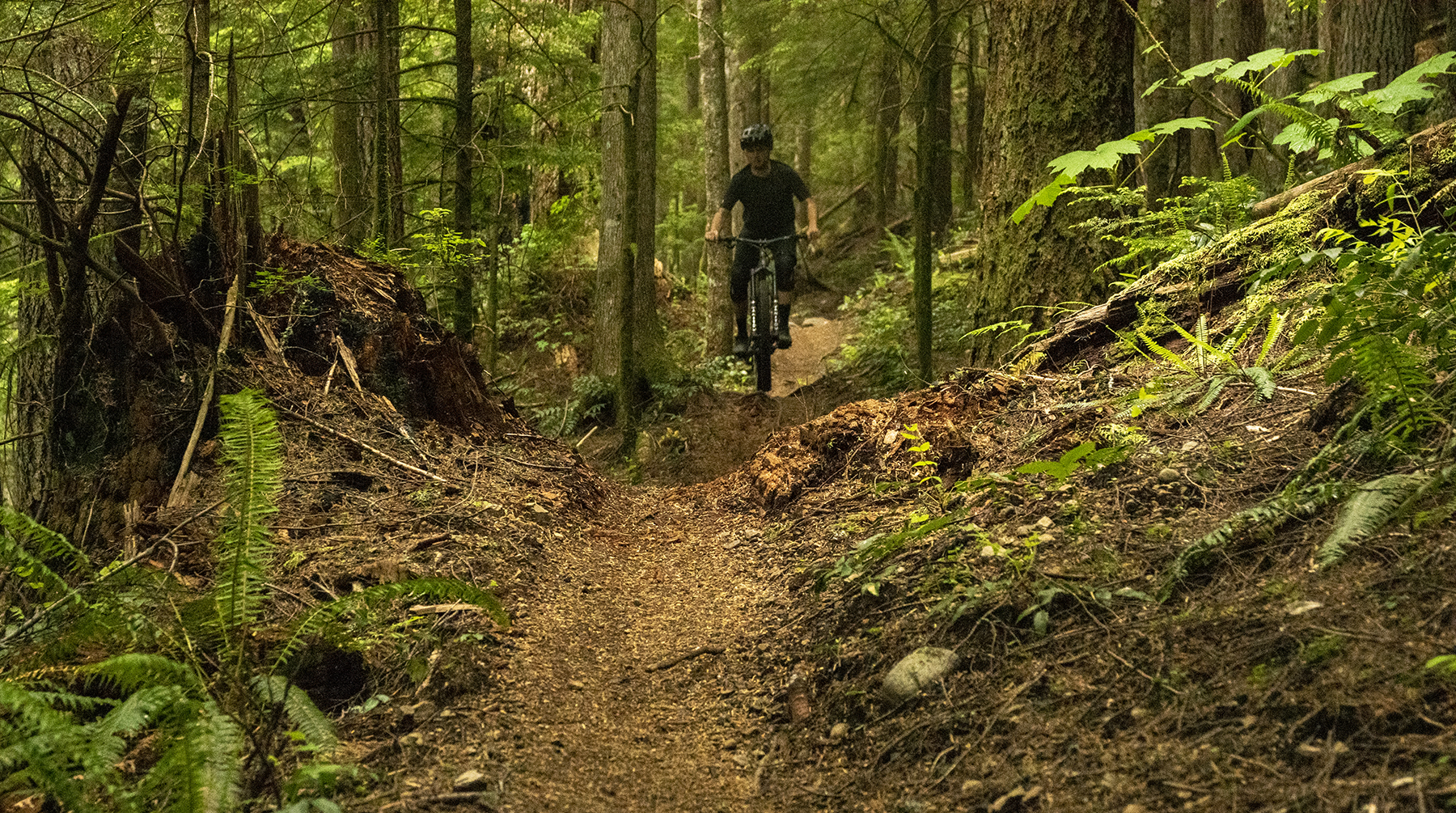
Fit & Sizing
Sage doesn’t list recommended rider heights for the Flow Motion on their website, but with a 491 mm reach and 636 mm effective top tube, the Large Flow Motion looked to be right in my personal wheelhouse, fit-wise, and the sizing did indeed feel great. The reach is somewhat on the long-ish side (especially for a hardtail, where reach grows slightly at sag with no rear suspension movement to counteract the front), but between the relatively steep seat tube and moderately wide 780 mm handlebar, the Flow Motion fits me very well both seated and standing.
Our review bike is actually the personal ride of Sage founder and owner David Rosen, and as such, the cockpit was fully set up for him when I first got on the Flow Motion. At 6’ / 183 cm tall, I’m a couple of inches taller than David, and right off the bat, it was clear that I needed to get the bars higher. The Fox 36 fork that the Flow Motion showed up with had its steerer tube trimmed to be run with no spacers, so getting the cockpit squared away for me meant swapping on a fork with enough steerer length that I could fit about 25 mm of spacers under the stem. I had a Manitou Mezzer Pro (a fork that I continue to be a huge fan of) on hand, and that did the trick.
I did find myself happy running the stock 780 mm wide bars on the Flow Motion (when I often prefer 790 mm ones on longer-travel Trail, Enduro, and DH bikes), I think both because of the somewhat long reach and correspondingly more stretched out body positioning on the Flow Motion, and because the Flow Motion feels a bit more like an all-rounder Trail bike than some of the extra-aggressive hardtails that I’ve been on recently — more on that below. The slightly short 35 mm stem probably helps, too, both in terms of overall fit and sizing, and by calming the steering down slightly to compensate for the narrower handlebar than I might often opt for. But all told, the combined setup made for a very comfortable fit with intuitive, straightforward handling, once I got the bar height squared away.
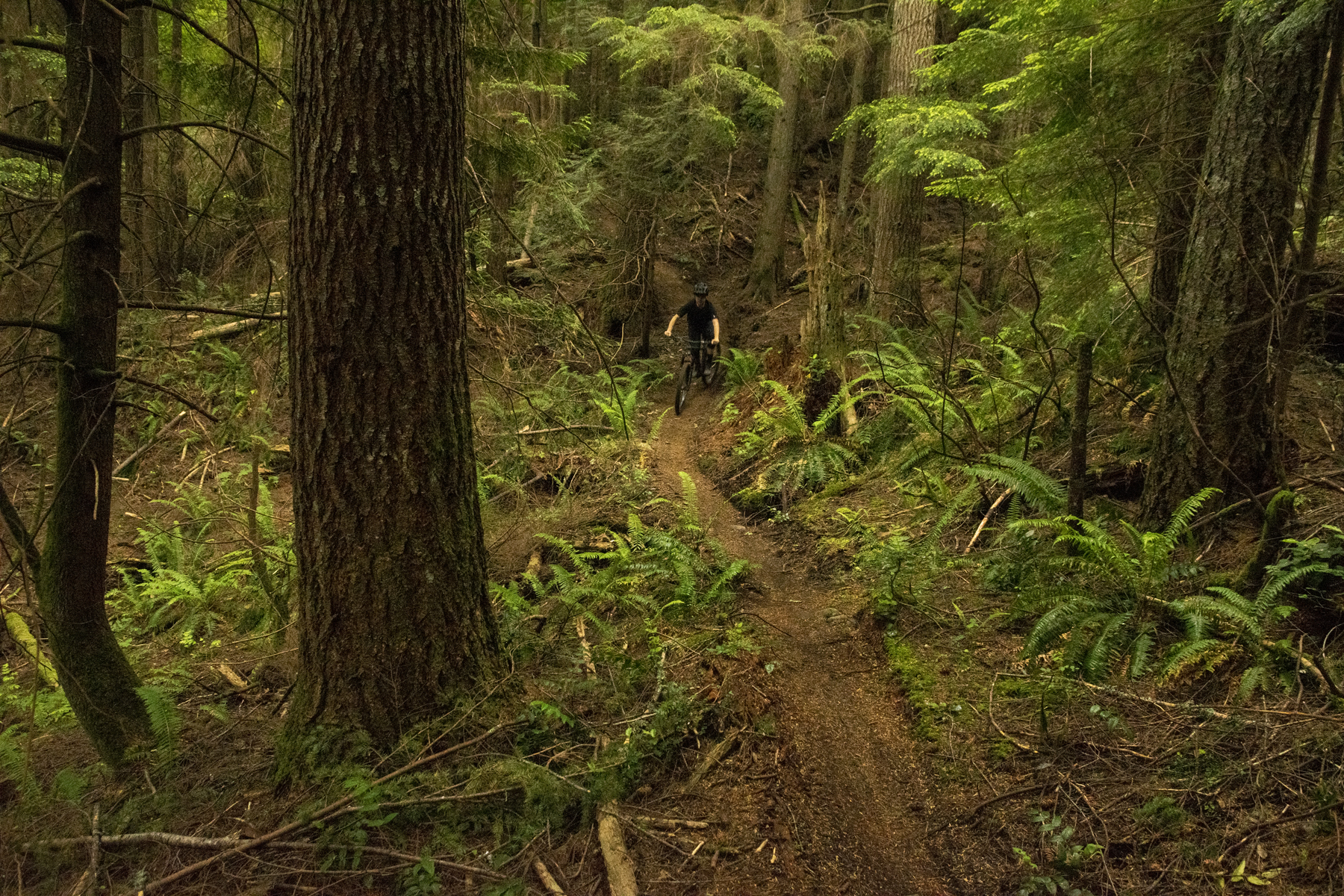
Climbing
As tested, the Flow Motion weighs 27.3 lb / 12.4 kg (without pedals), it’s built with fairly light wheels and tires, and it’s a hardtail. That all adds up to a bike that feels quite snappy and efficient when you get on the pedals. We probably shouldn’t be giving such revelatory information away for free.
But in all seriousness, the Flow Motion does climb really well. The low weight and pedaling efficiency of a hardtail go a long way toward that, but the pedaling position is well sorted and comfortable, and the handling at low speeds in tight spots is predictable and easy to manage. Despite the relatively short chainstays on our pre-production test bike, I didn’t have much trouble keeping the front wheel planted on even very steep fire road climbs, and the slightly longer chainstays on the production models (see the Geometry section, above, for more on that) should make things even more straightforward.
I’ve mentioned my appreciation for aggressive hardtails a whole bunch on Blister, but I do have to acknowledge that the slightly dialed-back geometry of the Flow Motion (as compared to things like the Marin El Roy or my personal BTR Ranger) does make for somewhat easier climbing manners. Particularly with hardtails, where rear-wheel traction is more limited, being able to pick lines carefully and precisely goes a long way toward keeping things moving forward, and the more moderate wheelbase and headtube angle of the Flow Motion certainly helps there.
As is going to be the case with any hardtail, the Flow Motion still rewards good technique when climbs get more technical and takes a bit more work and careful timing than a lot of full suspension bikes to loft up ledges and the like. There’s simply less traction, and more of a propensity for the rear wheel to break free when bouncing up and over something due to the lack of rear suspension — nothing out of the ordinary for a hardtail, but it does feel distinctly different from a full suspension bike, for folks who are used to those.
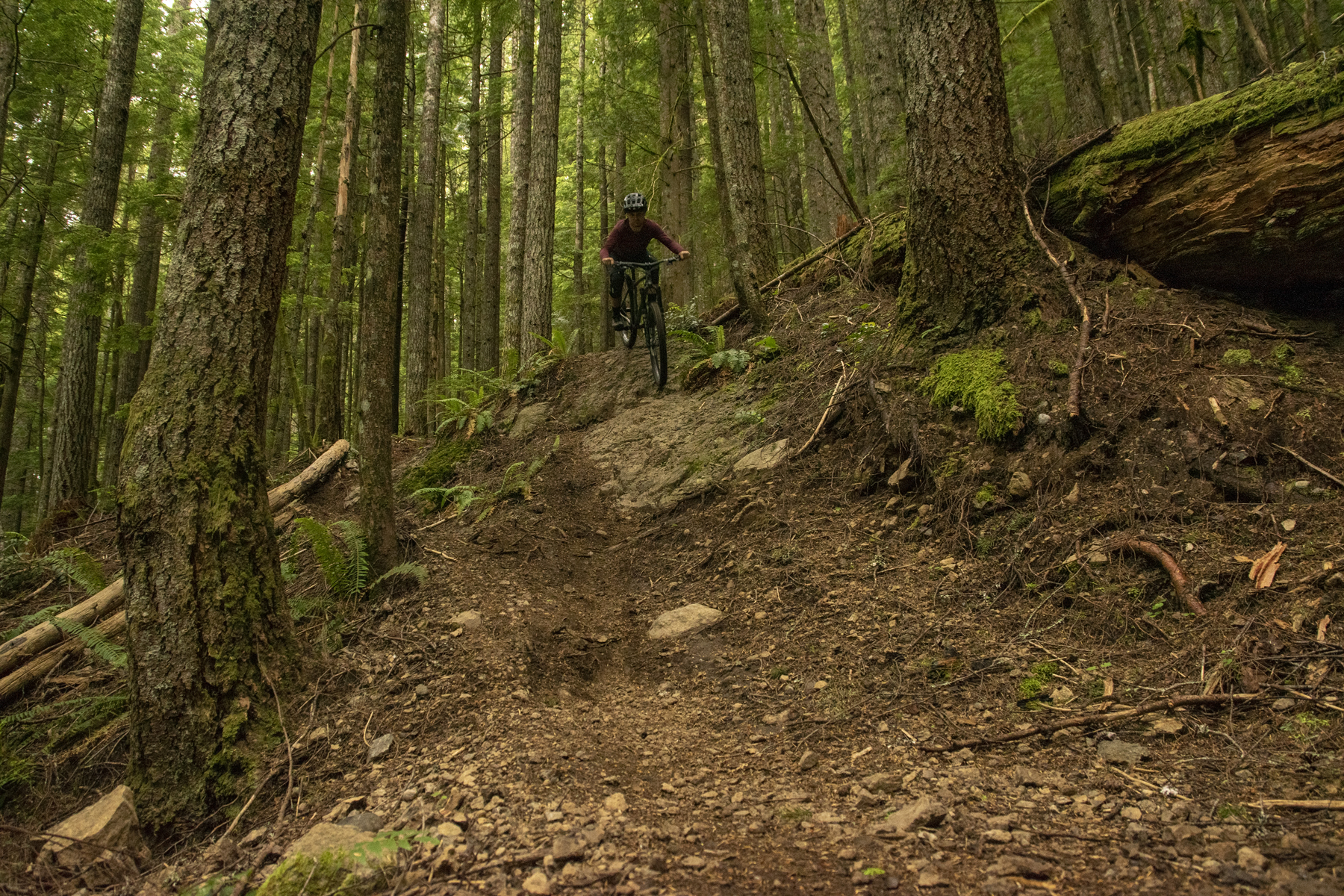
Descending
On the way back down, the Flow Motion strikes a really nice balance as a do-it-all Trail bike. It’s definitely less aggressive and purely descending-focused than options like the Marin El Roy and Kona Honzo ESD, but it’s no XC race bike, either. And for a bike that’s meant to do a little bit of everything, that’s a good place to be.
One of the striking things about the Flow Motion compared to those new-school ultra-aggressive Enduro hardtails is that it’s significantly easier to build speed by pumping through things — I think the slightly more moderate wheelbase and not-crazy-low bottom bracket go a long way there. Of course, the direct connection to the ground you get from a hardtail helps there, too, but even compared to other longer, lower hardtails, the Flow Motion is notably excellent. It’s lively, easy to manual, and generally more playful and easy-going than the most radical hardtails out there.
But that’s not to say that the Flow Motion feels like an overgrown BMX bike or anything like that. It’s still moderately long and slack, and is a bunch of fun on steeper, more technical trails, too. It’s not as stable as my personal BTR Ranger or (especially) the Marin El Roy but is substantially more so than alternatives like the Guerrilla Gravity Pedalhead. The steeper and rougher the trail gets, the more the Flow Motion requires you to ride fairly precisely, pick clean lines, and do a fair bit of work to pick up and move the bike around to deal with impacts. But it’s well-balanced, the handling is intuitive, and that all adds up to a bike that is comparatively easy to ride with the precision that it requires to really go fast on rougher, more technical trails. Especially if a lot of steeper trails are on the menu, I’d probably opt for bigger brake rotors (at least up front) than the 180 mm ones that our test bike showed up with, but that’s obviously an easy fix.
Compared to the most aggressive hardtails out there, the Flow Motion does feel a little less eager to load up the bike through the pedals and really rail corners; my hunch is that the more moderate bottom bracket height (as compared to the ultra-low Marin El Roy, for example) is a big part of the reason why. The Flow Motion still corners well, but it works best when staying a little more forward and driving weight through the front end, instead of settling down “into” the bike and pushing through your feet. It’s effective but doesn’t give quite the same sensation of having nearly infinite grip and really carving through the corner (almost akin to being on skis) that you can get out of longer, lower hardtails if everything goes right and you put it all together.
The slightly longer chainstays (432 mm on the size L) on the production model should make those bikes a touch more stable than our pre-production test bike and likely give the production Flow Motion a slightly bigger sweet spot in terms of body positioning than the version that we tested. With the shorter 425 mm chainstays on our review bike, the Flow Motion has a slight bias toward a forward stance and weighting the front wheel, but not by a huge margin; I’d expect the production bike to feel quite neutral in that regard.
The ride quality is also truly excellent. The Flow Motion feels notably smooth and muted over sharp impacts, for a hardtail. Obviously, that last qualifier is a big one — the Flow Motion isn’t going to trick you into thinking that you’re on a full suspension bike or anything like that. The best way I can describe it is that the Flow Motion does an impressive job of taking the edge off a lot of small, chattery impacts in particular. You still feel every one of them, but they’re just not as sharp or harsh as they are on most other hardtails. And over a long day on the bike, that really adds up in terms of overall fatigue. I wasn’t sure how the Flow Motion was going to feel on that front — it had been a really long time since I’d ridden any Ti hardtail, and I’d never been on one with this kind of geometry — but it’s the smoothest-riding modern hardtail I’ve been on to date, by some margin. Of course, there’s a lot more to that than just material selection (as demonstrated by the substantial differences between, say, steel hardtails) but Sage has hit upon a great recipe here.
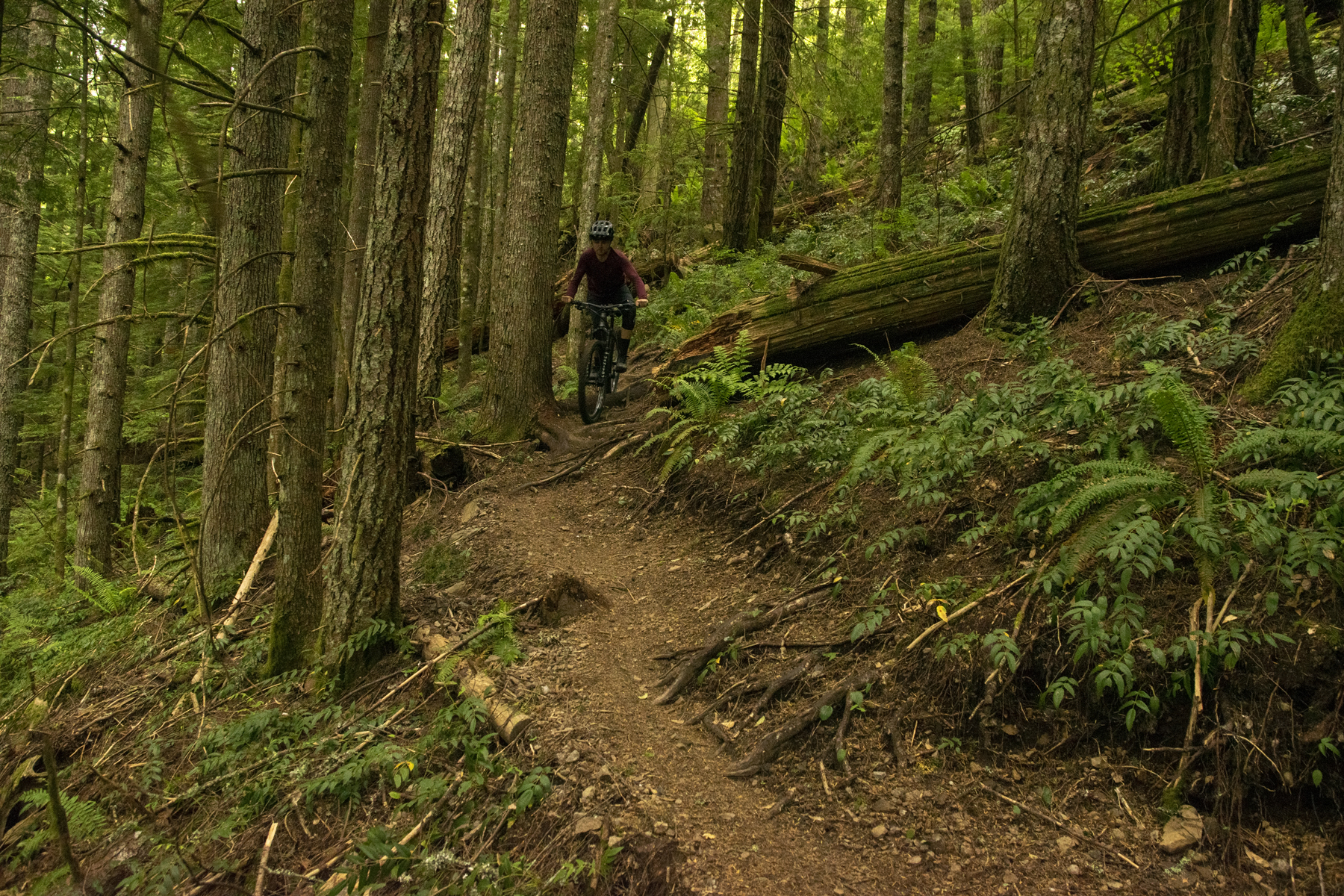
Who’s It For?
The Flow Motion is undeniably expensive, but it’s a great-riding, great-looking frame that’s made in the USA, and makes a strong case for folks who are willing to pay for that craftsmanship and a bike that should last a really long time. And while ultra-aggressive hardtails can be a ton of fun in the right terrain, the Flow Motion is a whole lot more versatile than the outliers in that class, while still being very capable when things get steeper and more challenging.
Bottom Line
The Sage Flow Motion is a very well-rounded Trail hardtail, with geometry that’s aggressive enough to feel comfortable on some steeper, more technical trails, but not so over the top as to feel like a highly specialized tool that’s awkward and out of sorts everywhere else. It’s also beautifully built, and the ride quality is outstanding. That doesn’t come cheap, but for folks willing to throw down for a dream bike, the Flow Motion is a worthy candidate.


As a hard tail rider myself, I find tire size makes a huge difference in the “suspension” of a bike. What size tires is this bike running?
Right now it’s got a 2.4 Magic Mary front and 2.25 Nobby Nic rear. I’m inclined to put something a little burlier in back but I’ll give it a few more rides before I start swapping parts.
Sage makes beautiful frames, but I question a few of their decisions.
An aggressive HT should cheerfully accept a 2.6 rear tire.
I’m a fan of full length cables, but the world seems to be demanding internal routing. AXS for this bike, as it sits.
The rest? Nailed it!